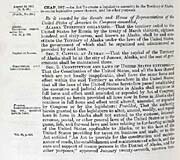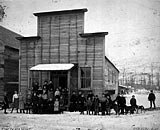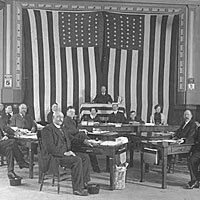Governing Alaska
Alaska gets a Legislature

Organic Act of 1912
An act to create a legislative assembly in the Territory of Alaska, to confer legislative power thereon, and for other purposes.
Most notably, the legislature was forbidden to control matters related to fish and game, borrow money, create counties, or deal with the management or disposition of land. This meant that powers dealing with natural resources, land, and money would remain with the federal government - exactly what the large fishing and mining companies wanted. In addition, any action of the legislature could be overridden by Congress, or vetoed by the governor, who was still a federal appointee. The legislature had limited powers to tax its citizens.
Given the strong opposition to the legislative bill by the mining and fishing companies who were worried about high taxes, Wickersham thought the bill was the best compromise. He said it was "as good a bill as the people of any territory have had and gave Alaska home rule without the expenditure of a nickel."
In opening remarks before the first territorial legislature, Rep. Charles Ingersoll of Ketchikan noted the severe limitations Congress had placed on the body. "Looking for the substance we find the shadow. Asking for bread, we get a stone," he said. "History repeats itself. When our fathers met to form the constitution of the United States, they felt that same distrust of the rank and file of the people that Congress has manifested in passing the Territorial Act. Between the lines there runs that careful trimming of the sails, the effort to avoid sunken reefs, that same distrust of permitting the common people to have a voice in the government."
Wickersham addressed the territorial legislators the following day. Stung by the criticism, he questioned Ingersoll's motives, saying that perhaps he was in the pocket of the absentee fishing companies who would naturally object to any efforts to protect fishermen and prevent exploitation of fishing resources.
One of the legislators had served in the Washington legislature, another had served in Oregon and a third had served in the California legislature. "We had a copy of one of the proceedings of the Oregon legislature and on that we organized and started in," said Charlie Jones, a miner who represented Nome.
For all of the complaints about its lack of power, the legislature dealt with many issues during its first 60-day session. It approved 84 bills that helped fill out the new governmental organization
Lawmakers gave women the right to vote, and instituted a $4 head tax on all men between 21 and 50 who were not volunteer firemen. In today's dollars, that would be about $75 per person. The money from this tax was to be used to build roads. They amended the mining laws, adopted laws to regulate banks, made school attendance compulsory and allowed local governments to organize and enforce rules for health and sanitation.One of the most difficult issues was whether the work day should be limited to eight hours in certain occupations. Legislators approved an eight-hour day for the machinery-intensive hard rock mining industry, but refused to extend it to the labor-intensive placer mining indusry or to women workers.
The Legislature also approved plans for what became the first Alaska Pioneers Home, designed to help poor prospectors. They made numerous requests to Congress for federal action, including two that would have long-lasting consequences. One was to ban the use of fish traps and the other was to build railroads to make Alaska more accessible.
While fish traps remained a contentious issue until statehood in 1959, the federal government soon agreed to build a railroad- a decision that helped determine the direction of Alaska's future.
The Legislator's Challenge: Travel
The toughest challenge for members of the first Alaska Legislature was to get to Juneau. In 1913, when no one had even dreamed of a town called Anchorage, lawmakers came from places like Nome, Ruby, Candle, Iditarod, Seward, Juneau, Valdez and Fairbanks.
There were no airplanes in Alaska , (the first flight took place in the summer of 1913 in a Fourth of July exhibition in Fairbanks) and dog teams were the fastest means of winter travel.
The new legislature was permitted to meet only in odd-numbered years and only for 60 days. Three of the legislators-to-be left Nome by dog team in early January. They crossed Norton Sound to Unalakleet and traveled the Yukon River and then the Tanana River to Fairbanks. They covered 700 to 900 miles just to reach Fairbanks. One senator walked from roadhouse to roadhouse along the winter trail to Fairbanks. From there they went 360 miles by horse-drawn sleigh to Valdez, a journey that took a week, and caught a steamer to Juneau. They arrived the day before the Legislature began.
The Legislature was made up of five lawyers, one doctor, five businessmen, one fisherman and eleven miners. Their ages ranged from 33 to 63. The pay was $15 a day,( about $275 per day in 2004 dollars) and the travel allowance was 15 cents per mile, or about $2.75 in 2004 dollars. Gov. Walter Clark estimated that the average lawmaker had to make a round-trip of 2,541 miles to reach the capital. There was no government building in Juneau, so the legislators met on two floors of the Elks Hall. They began their work on March 3, 1913. The next day, 3,000 miles away in Washington, D.C., Woodrow Wilson was sworn in as the 27th president of the United States.Women Gain the Right to Vote
As the U.S. House of Representatives debated details of the law that would grant Alaska its first Legislature, in 1912 a Socialist Congressman from Milwaukee rose to insist that the Alaska Legislature ought to be allowed to give women the right to vote. "The time has gone by when all women looked after the kitchen and the dining room," said Rep. Victor Berger. "Now they go into offices, school rooms and factories, where they do a man's work, and they should have the same economic and political rights as men. . ." The debate took place on April 24, 1912, nine days after the sinking of theTitanic, where the priority for lifeboats was "women and children first."
With this in mind, one of the Congressmen who thought women should not be allowed to vote, asked, "If they got the same rights as men would they enjoy the same privileges as they enjoyed on the Titanic?" Berger said yes because "the saving of the race is left to the women."
For decades, women's groups in the United States had fought for the right to vote, making the most headway in the American West. Rather than directly grant Alaska's women the right to vote, Congress gave that power to the Alaska Legislature when it approved the law creating the Territory of Alaska, signed by President Taft on Aug. 24, 1912.
When the First Territorial Legislature met, its first act was to unanimously approve a bill to allow women to vote.
Legislators said that women had proven themselves in Alaska and did much to support its development. Others believed that allowing women to vote was important because it would increase the number of voters, which would impress government officials who questioned the stability and the future of Alaska. Sen. Henry Roden of Iditarod said it was an easy issue to deal with because it did not "cost any member anything, nor their friends."
Gov. Walter Clark said there had been no demand from Alaska women to vote, but he signed the bill "without hesitation." He said it would only be important if women took the time to vote as "we have a large enough inactive citizenship already -not only in Alaska, but in the States as well."
This Alaska action was praised by supporters of women's suffrage in the United States. The Seattle Sun commented that "Alaska is nothing if not progressive." At that time only nine states (Idaho, Wyoming, Utah, Colorado, Washington, California, Oregon, Arizona and Kansas) had granted women the vote, but the trend was turning. Two years after Alaska joined that list, Gov. John F. Strong said the practice of voting by women had not "unsexed them nor caused them to take on 'unwomanly attributes' or unfitted them to become wives and mothers, or to attend to their domestic duties generally." The 19th amendment, extending suffrage to all women, became part ofthe United States Constitution on August 18, 1920.
Prohibition in Alaska

Destroying bottles of alcohol at Nome during Prohibition (video)
Clip shows people at a trash dump in Nome, Alaska, destroying bottles of alcohol. This occurred during prohibition days.
He believed that granting women the right to vote in 1913 had been critical in the campaign against alcohol. "To the votes of the women of Alaska may be ascribed the crystallization of public sentiment against the liquor traffic in the territory," the Governor said. The advisory vote in Alaska won in 1916, by more than a two-to-one margin. The only places that didn't vote to go dry were Eagle, St. Michael and the nearly abandoned town of Chena, near Fairbanks.
Congressional Delegate James Wickersham said the anti-liquor sentiment was due to dissatisfaction with the way saloons were being run - they were regarded as a "menace to many people."
The results of the advisory vote were sent along to the U.S. Congress, which still had the right to make laws about liquor for Alaska. It approved the so-called "Bone Dry Law," which went into effect at the start of 1918.
Two years later the 18th Amendment went into effect and alcohol was banned throughout the United States. Thirteen years after that, because the nation had changed its mind about banning drinking, the 21st Amendment repealed the 18th and alcohol became legal again.
The First Statehood Movement
In 1916, Alaska Delegate James Wickersham introduced the first bill to grant statehood to Alaska. The topic had been discussed for decades by that time, but nothing had ever come of it.
One of the earliest supporters for admitting Alaska to the union was none other than former Secretary of State William H. Seward. He had visited Sitka in 1869, two years after Alaska became an American territory. In his address at Sika, he laid out his vision for Alaska, "first as a terrritory, and ultimately as a state or many states."
In 1916, frustrated by the limits placed on the territory that handcuffed the legislature, Wickersham wrote a statehood bill for Alaska, patterned after the act that admitted Oklahoma in 1906. He introduced it on the 49th anniversary of the Alaska purchase treaty and said "if the the iron bands of government repression" could be released, the new 49th state could be the "richest and greatest of them all." Wickersham did not believe his statehood bill would be approved right away. In fact, at a gathering in Anchorage he took pains to point out the many costs that would come with admission to the Union. He also said there was no need to worry, that it was only a matter of time before it would become a state, and by then the territory would have the financial ability to cover its expenses.
"We hear the first gentle rapping of Alaska at the door of statehood," the Portland Telegram said. Historian Claus Naske said that one of the reasons Wickersham's proposal drew so little notice was that "gentle rapping" has never worked in such matters. Pounding on the door was more likely to succeed, but Wickersham realized that the time was not right for an all-out statehood campaign.
Links:
- Women's suffrage
- Prohibition in the U.S.

